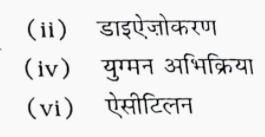संयोजकता आबंध सिद्धांत के आधार पर निम्निलिखित उपसहसंयोजन सत्ता में आबंध की प्रकृति की विवेचना कीजिये-
i) [Fe(CN)6]4−
ii) [FeF6]3−
iii) [Co(C2O4)3]3−
iv) [CoF6]3−
Step by step video & image solution for संयोजकता आबंध सिद्धांत के आधार पर निम्निलिखित उपसहसंयोजन सत्ता में आबंध की प्रकृति की विवेचना कीजिये- i) [Fe(CN)_(6)]^(4-) ii) [FeF_(6)]^(3-) iii) [Co(C_(2)O_(4))_(3)]^(3-) iv) [CoF_(6)]^(3-) by Chemistry experts to help you in doubts & scoring excellent marks in Class 12 exams.
Updated on:21/07/2023Topper's Solved these Questions
Similar Questions
निम्नलिखित उपसहसंयोजन यौगिकों के सूत्र लिखिए-
i) टेट्राएमीनडाईएकवाकोबाल्ट (III) क्लोराइड
ii) पोटैशियम टेट्रासायनीडोनिकैलेट (II)
iii) ट्रिस (एथेन-1,2-डाईएमिन) क्रोमियम (III) क्लोराइड
iv) एम्मीनब्रोमीडोक्लोरिडोनाईट्रिटो-N-प्लैटिनेट (II)
v) डाइक्लोरोबिस (एथेन-1,2-डाइऐमीन) प्लैटिनम (IV) नाइट्रेड
vi) आयरन (III) हेक्सा सायनाइडोफेरेट (II)
View Solutionयघपि नाइट्रोजन +5 ऑक्सीकरण अवस्था दर्शाता हैं। लेकिन यह पेन्टाहैलाइड नहीं बनाता । कारण दीजिए।
View Solutionनिम्न पर लघु टिप्पणी लिखिए-

View SolutionDiscuss the nature of bonding in the following co-ordination complexes on the basis of valence bond theory : (a) [Fe(CN)_(6)]^(4-) (b) [FeF_(6)]^(3-) (c) [Co(C_(2)O_(4))_(3)]^(3-) (d) [CoF_(6)]^(3-)
View SolutionThe magnetic moment of complex given below are in the order: (I) [Ni(CO)_(4)] (II) [Mn(CN)_(6)]^(4-) (III) [Cr(NH_(3))_(6)]^(3+) (IV) [CoF_(6)]^(3-)
View SolutionDiscuss the nature of bonding in the following coordination entities on the basis of valence bond theory : (i) [Fe(CN)_(6)]^(4-) (ii) [FeF_(6)]^(3-) (iii) [Co(C_(2)O_(4))_(3)]^(3-) (iv) [CoF_(6)]^(3-)
View SolutionThe hybridization of [CoF_(6)]^(3-) and [Co(C_(2)O_(4))}^(3-) are :
View SolutionHow many of the following complexes are expected to have d^(2)sp^(3) hybridisation ? [Mn(CN)_(6)]^(3-)," "[MnCl_+(6)]^(3-), [Fe(CN)_(6)]^(3-),[FeF_(6)]^(3-)," "[CoF_(6)]^(3-), [Co(C_(2)O_(4))_(3)]^(3-)," "[MnBr_(4)]^(2-)
View SolutionThe hybridization of [CoF6]3− and [Co(C2O4)}3− are :
View SolutionHow many of the following complexes are expected to have d^(2)sp^(3) hybridisation ? [Mn(CN)_(6)]^(3-)," "[MnCl_+(6)]^(3-), [Fe(CN)_(6)]^(3-),[FeF_(6)]^(3-)," "[CoF_(6)]^(3-), [Co(C_(2)O_(4))_(3)]^(3-)," "[MnBr_(4)]^(2-)
View Solutionसंयोजकता आबंध सिद्धान्त के आधार पर निम्नलिखित उपसहसंयोजक सत्ता में आबंध की प्रकृति की विवेचना कीजिए-
(i) [Fe(CN6]4−
(ii) [FeF6]3−
(iii) [Co(C2O4)3]3−
(iv) [CoF6]3−
View SolutionThe magnetic moment of complex given below are in the order: (I) [Ni(CO)_(4)] (II) [Mn(CN)_(6)]^(4-) (III) [Cr(NH_(3))_(6)]^(3+) (IV) [CoF_(6)]^(3-)
View SolutionWrite the IUPAC names of the following complexes i) K_(3)[Fe(CN)_(6)] , ii) [Pt(NH_(3))+_(6)](SO_(4))_(2) , iii) Kfe^(III)[Fe(CN)_(6)] , iv) Cs_(2)[Co^(II)Cl_(4)] and v) [CoF_(6)]^(-3) .
View SolutionI. K4[Fe(CN)6]
II. K3[Cr(CN)6]
III. K3[Co(CN)6]
IV. K2[Ni(CN)4]
संकुलों में से प्रतिचुम्बकीय है
View SolutionThe magnetic moment of complex given below are in the order: (I) [Ni(CO)_(4)] (II) [Mn(CN)_(6)]^(4-) (III) [Cr(NH_(3))_(6)]^(3+) (IV) [CoF_(6)]^(3-)
View Solution
